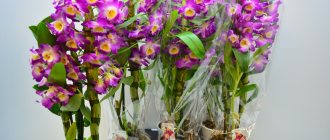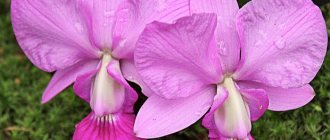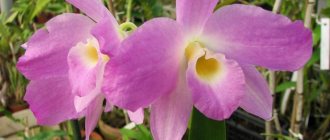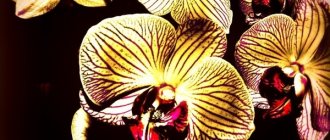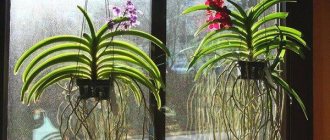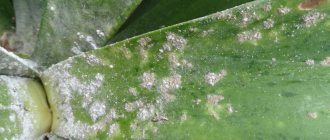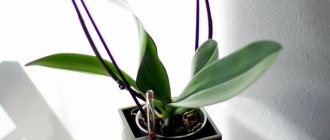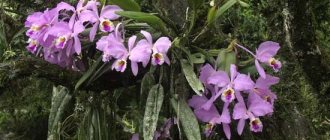There are special beauties among orchids that will delight you with their six-month flowering and also with their stunning aroma, like the Berry Oda dendrobium. Despite the modest size of the bush, it is capable of producing three times more flower stalks than it has stems. In addition, this variety does not tolerate high temperatures as hard as most dendrobiums. Where does such a fantastic power come from in a small bush and what is the secret of its abundant flowering?
Types of dendrobium orchids and hybrids
Dendrobium is a genus of deciduous and evergreen plants of the Orchidaceae family. Natural habitat - Asia, Australia, New Zealand and the Pacific Islands. More than 900 species are united under the name Dendrobium, among which there are both epiphytes and lithophytes.
The most common varieties and varieties:
- Dendrobium nobilis is an epiphytic plant found wild in the highlands of Southeast Asia. On tall, erect shoots of the orchid, lanceolate leaves with a glossy coating develop. During the flowering period, arrows topped with several large, fragrant flowers appear from the axils of the leaf blades. The color is varied: it can be monochromatic or combined.
- King's Dendrobium is a compact and undemanding species native to the Australian continent. The plant develops as a lithophyte. Several shoots with sessile leaves grow from the pseudobulbs. Peduncles are a continuation of the stems. They bloom with beautiful flowers of white, red, pink and lilac colors.
- Dendrobium "Berry Oda" is a hybrid that can easily tolerate higher temperatures compared to other species. Thickened stems emerge from the pseudobulbs. The flowering period, during which many small flowers bloom, can last about six months. "Berry Oda" is compact and does not exceed 40 cm.
- Dendrobium "Sa-Nuk" is the fruit of the work of Thai breeders. It is distinguished by its ability to bloom again after 5-7 months. The inflorescences resemble the common phalaenopsis orchid.
- Dendrophalaenopsis is an orchid with pseudobulbs, from which erect stems with lanceolate green leaves develop. Flowering is abundant: up to 20 flowers can bloom on each peduncle. The older the plant, the more inflorescences it has.
Important!
Dendrobium Berry Oda is a species hybrid of Dendrobium kingianum and two other natural species. It owes its long flowering and delicate aroma to the latter.
Useful video
The video shows how to separate and plant the baby:
Find out interesting information about other types of orchids: Odontoglossum, Cymbidium, Vanda, Oncidium, Cambria, Coelogina, Cattleya, Ludisia precious, Miltonia, mini orchids, Brassia
The Berry Oda orchid is not only beautiful, but also very fragrant. Blooms for a long time, easy to care for. This plant adds sophistication and sophistication to the interior.
Conditions and care
To decorate the windowsill with an exotic plant, it is necessary to provide comfortable conditions for the dendrobium orchids. In addition, it is important to properly care for the tropical beauty - organize a proper watering regime and fertilizing.
Temperature and lighting
To place a container with a flower, set aside a place on the windowsill of an east or west window. Dendrobium needs plenty of bright light. But direct sunlight is harmful to it. In winter, the plant should be provided with additional lighting for 5 hours.
Keeping temperature – 25 °C. After the pseudobulbs ripen, it is recommended to keep the flower in a room with temperature values in the range of 12-15 °C.
Soil and container
It is better to grow dendrobium in a clay pot. It is more stable. The volume of the container must correspond to the root system of the plant.
To fill the pot, use a substrate made from a mixture of orchids, moss, pieces of pine bark, a small amount of pumice and perlite. The latter can be replaced with coarse river sand. To prevent the roots from rotting due to stagnant moisture, be sure to organize drainage from a thick layer of pine bark.
Watering and humidity
Moisturize the orchid moderately. During the period of active growth, the frequency of watering is once a week. Before a new portion of water, the humidity of the substrate should be controlled: the roots must have time to dry out. In winter, after the pseudobulbs ripen, watering is practically stopped.
If the apartment has high temperatures, the humidity should be increased. At the same time, it is necessary to systematically ventilate the holding room, otherwise pathogenic fungi may begin to develop.
Feeding and fertilizer
In spring and summer, the plant is fed twice a week. Complex fertilizers are used as nutritional compositions. Prepare the solution as described in the instructions on the package, depending on the drug. From mid-autumn until the end of winter, you should not feed the orchid.
Transfer
The flower is rarely replanted - if the soil is highly salinized, the roots are rotting due to overwatering or a cramped pot. The optimal time for transplanting the Berry Oda hybrid is when the new shoots reach a height of 5 cm, when they begin to develop their own roots.
Important!
Dendrobiums are painful to endure the transplantation procedure. You should take this into account when choosing a new container so that after a year it does not become small.
Transplantation
Preliminary actions consist of selecting a pot, disinfecting it, and preparing the appropriate tools - a bamboo support, scissors, tweezers, and a wooden stick. Step by step transplantation of dendrobium is carried out as follows:
in order not to injure the plant, the soil lump is spilled with water and left to soak for several minutes; You need to carefully remove the plant by grasping it by the leaf rosette and pulling it up a little; then you should rid the orchid of soil particles, wash the root system - to do this, put the plant in a solution of succinic acid and “Epin” (growth stimulant) for half an hour; the procedure simultaneously increases the immunity of the crop and makes it less susceptible to disease; after this, you can remove the old soil, cut off the damaged and dead parts of the roots with a disinfected knife, remove moss and rot with tweezers; the next stage is treating the roots with a weak peroxide solution; damage to the shoots is sprinkled with coal, and then the dendrobium is placed under a phytolamp and dried; Drainage holes should be made in the bottom of the container; the size of the pot should not be too large; prepared drainage material is placed down; the flower is immersed in the center, the root system is straightened, then carefully sprinkled with soil, without trying to compact it - over time, the roots will arrange themselves in a way that is more convenient for them; It is not recommended to water the flower immediately after diving, but the air in the room should be well humidified; care consists of placing the pot on a light, slightly shaded windowsill, because the plant needs light, but it must be diffused; Irrigation is carried out after 2-3 days, when the root system begins to take root.
A correctly carried out transplantation procedure will enable the plant to quickly adapt and strengthen in the substrate, which is important for the further development of the orchid. Flowers need to be watered with warm, settled water often, but not a lot, just maintaining humidity
This is done more often in the summer. It is also necessary to periodically refresh the leaves with a shower, but then dry them thoroughly with cotton pads, not forgetting about the growth buds. In winter, the plant needs rest, so the watering procedure is minimally reduced.
Important! You can feed a dendrobium orchid only during its active growth; for example, spraying with diluted glucose will benefit the flowers. The main mistakes made by orchid lovers who do not have sufficient experience are deepening the root system, replanting with intertwined roots, removing bulbs and peduncles, which leads to damage to the orchid and a halt in its development.
In general, such a southern culture as dendrobium does not require complex care and special conditions for abundant flowering, but knowledge of the intricacies will help to avoid difficulties with growing
The main mistakes made by orchid lovers who do not have sufficient experience are deepening the root system, replanting with intertwined roots, removing bulbs and peduncles, which leads to damage to the orchid and a halt in its development. In general, such a southern culture as dendrobium does not require complex care and special conditions for abundant flowering, but knowledge of the intricacies will help to avoid difficulties with cultivation.
Propagation of the Berry Oda orchid
The plant is bred vegetatively. You can resort to cuttings or divide the mother bush when transplanting.
In the first case, parts of the shoots with several internodes are cut and buried in a special substrate for orchids. The cuttings are covered with plastic caps and wait for the roots to appear. When this has happened, new specimens can be planted in permanent pots.
When dividing the mother bush, the children are planted in separate containers. The pots are placed for several days in a room with soft light and a temperature of at least 22 °C.
Photo
The photo shows popular colors of this variety:
Read about all the varieties of dendrobuim orchids in this article.
Description of the plant
Dendrobium (lat. Dendrobium) is a herbaceous perennial orchid. Belongs to the Orchidaceae family. The name was coined by the Swedish botanist Olaf Schwartz when he first discovered it in the Caribbean in 1799. He combined two Greek words: “dendron” - “tree” and “bios” - “life”. Indeed, most Dendrobiums grow on trees as epiphytic plants, and the translation from Greek means “tree-dwelling.” In fact, in addition to epiphytic Dendrobiums, there are lithophytes that grow on rocks, i.e. on the stones.
There are more than 1,500 species of epiphytes and lithophytes in the genus Dendrobium. In the wild, they can be found in Australia, Japan, the Philippines, New Guinea and New Zealand, in the tropical forests of South Asia and Polynesia. Natural tropical species of Dendrobiums find it difficult to adapt to life in city apartments. But breeders have developed hybrid forms of these orchids that take root well and bloom at home. Dendrobiums are second in popularity among orchids, after Phalaenopsis.

